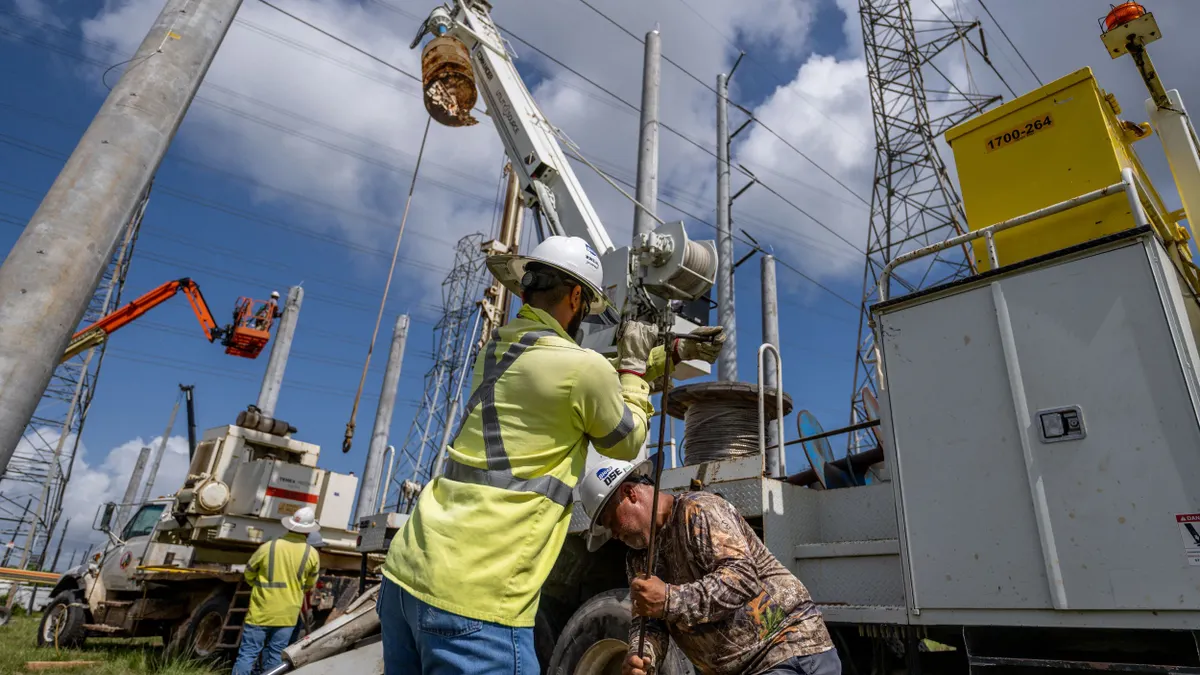Last year, about 6.5% of United States electricity generation came from utility-scale wind or solar resources. It's a deceptive number, as it belies much higher portions of clean energy in specific areas and doesn't indicate growing renewable portfolio standards around the country.
Despite the relatively modest amount of intermittent renewables in play right now, grid operators in all areas of the country are preparing for more. While it is a high-profile challenge — and the basis of the U.S. Department of Energy's recent grid reliability study — the general sense is that much greater levels of renewable energy can be integrated if the grid is made more flexible.
A report funded by the Advanced Energy Economy Institute and the American Wind Energy Association concluded the power mix is changing largely due to cheaper natural gas, flat demand and more efficient generation. And while the shift has forced a significant amount of coal-fired generation offline, the report concluded the transition to a cleaner mix of fuels is not harming the reliability of the power grid.
In 2012, a frequently-cited study from the National Renewable Energy Laboratory's (NREL) Renewable Electricity Futures Study concluded 80% renewables by 2050 is achievable for the country, with almost 50% coming from variable wind and solar photovoltaic generation. But preparations at the transmission level will need to be made, along with utility-side efforts.
The study found that "increased electric system flexibility, needed to enable electricity supply-demand balance with high levels of renewable generation, can come from a portfolio of supply- and demand-side options, including flexible conventional generation, grid storage, new transmission, more responsive loads, and changes in
power system operations."
That is the direction, in many regions, that the nations' electric grid is already heading. So what's the big deal?
For regional grid operators, there are both planning and operational challenges. Higher levels of renewable energy can mean steeper load ramps or negative pricing, while accommodating it requires balancing long-term planning with short-term forecasts. The challenge extends beyond moving green power from generator to consumer, and includes grid balancing and market optimization.
"We know it takes a lot longer to build a transmission project than it typically does for a generation project so you do have to be thinking ahead," said Jennifer Curran, vice president of transmission for Midcontinent ISO. "The challenges with a new transmission line tend to be siting related. You could be building many miles. ... that process can be as much as five years, and a wind turbine can come online is less than two. There is a timing mismatch."
MISO recently launched a multiyear study of renewable energy integration and its impacts on grid reliability, looking to address any limitations, including whether battery storage is required and which areas of the grid might first be impacted by the change in resources.
The grid operator is continuing to execute on $5.5 billion in transmission projects examined several years ago, to help states meet renewable portfolio standards. But with a growing volume of capacity in the MISO interconnection queue, the integration study will examine what other action is needed, either market-based or infrastructure.
"My hypothesis is, we will find we need both," said Curran. "But the reality is, we won't know for sure until we do some analysis."
There is currently about 15 GW of wind on the MISO system, and another 31 GW of wind and 16 GW of solar in the interconnection queue. Not all of that will ultimately be developed, said Curran, but the direction is clear: "More renewables are coming."
Markets
One way in which renewables can be integrated smoothly, said Curran, is to develop products and pricing mechanisms that help to efficiently value and dispatch intermittent generation.
"If you have more renewables coming online you may need to have different products to make sure you have right resources online at right time," said Curran. When MISO first started having wind show up on its grid, it developed a Dispatchable Intermittent Resource product as a way for the market to dispatch the new resource.
In California, which has one of the most ambitious clean energy policies in the country, utilities have been consistently adding renewables resources to their portfolios since the state's RPS was put in place 15 years ago. The state has been debating the idea of a 100% renewables goal, though right now it is targeting 50% by 2030.
Steven Greenlee, a spokesman for the California ISO, said the grid operator has kept pace with the utilities increased renewables procurements by "streamlining our generator interconnection study processes, identifying and implementing market enhancements that support the unique operating characteristics of variable wind and solar resources as well as energy storage, and making the grid ready for devices that can both produce and consumer energy such as energy storage and electric vehicles."
The CAISO grid has more than 20,000 MW of intermittent resources, including 6,000 MW of wind, about 10,000 MW of utility-scale solar, and an estimated 5,000 MW or more of rooftop solar.
And, California is expecting approximately 4,000 MW of additional transmission-connected renewables by 2020 and an additional 10,000 MW to 15,000 MW by 2030.
CAISO is looking at a wide range of methods to integrate this volume of intermittent energy, including: storage, time-of-use rates, demand response, an expansion of the Western Imbalance Market, regional coordination and electric vehicle charging.
Last year, the western EIM helped to avoid curtailing over 332,000 MWh of wind and solar, according to CAISO.
"Being able to share excess renewable energy via the EIM's real-time market is an important tool in managing the influx of new variable resources needed to meet the state's energy goals," said Greenlee. The grid operator is also considering expanding the ISO day ahead market to utilities outside of California, he said.
Rapid additions of solar resources have led to oversupply conditions during some mid-day hours, he added, when solar production spikes and demand lags, resulting in times of negative prices and highlighting the need for flexible ramping resources. But "while variable resources have their operational challenges, the California ISO has always been able to reliably operate the grid with them," Greenlee said.
Greenlee also said that traditionally, retail rates in California have incentivized energy use in the early morning or late evenings, "but the Public Utilities Commission is moving to better align rates tiers with energy supply so it will be financially advantageous to consumers to wash and dry clothes in the middle of the day, for instance."
The California ISO has also developed a market mechanism that enables the aggregation of distributed energy resources, such as battery storage and electric vehicles, "so the bundled resources can participate in the wholesale markets just like a traditional power plant," he explained.
The Electric Reliability Council of Texas introduced its nodal market, allowing for locational marginal prices at the end of 2010. And at the same time, ERCOT also moved from a 15-minute dispatch resolution to a 5-minute resolution. A Brattle report noted it was "one of the main reasons why ERCOT has been successful in integrating renewables with minimal increase in Ancillary Services."
By some estimates, ERCOT could have almost 30 GW of wind on its system within the next three years.
In PJM, the level of renewables is "small but growing," according to a recent presentation. Renewables made up about 4.5% of PJM's generation mix last year. But by 2032, the operator expects almost 14% of load will be serving state RPS requirements.
The operator has implemented a centralized wind power forecast service, and is developing a solar power forecast, to better predict resources. And PJM has implemented changes to improve wind resource dispatch and control, as well as demand response and price-responsive demand to improve operational flexibility.
Infrastructure
While market issues can be used to optimize pricing and shift load to times when there is plentiful fuel-free energy, often physical constraints must be addressed.
One of MISO's advantages in integrating renewable energy has been its size. While planning is always done with an eye towards the possibility for system overloads, or frequency or voltage issues, the issue is not a matter of total renewables on the system.
"MISO is very big geographically and has a lot of load and is fairly well interconnected," said Curran. "We've found we have the ability to absorb quite a bit of wind. It's one of the benefits of having an operation of this scale."
The upcoming study will address the potential need for new transmission, in addition to the large package of projects approved in 2011.
In ERCOT, a long-term assessment last year found a combination of high amounts of solar generation additions in the west and generation retirements in the east of the state "will result in a significant increase in west-to-east
power flows on the transmission network. This will result in the need for transmission system improvements to reliably accommodate these flows."
All of the scenarios ERCOT examined showed significant solar generation additions and the retirement of coal and natural gas generation.
A 2014 study by GE Energy Consulting found the PJM system, "with adequate transmission expansion and additional regulating reserves, will not have any significant issues operating with up to 30% of its energy provided by wind and solar generation."
"No insurmountable operating issues were uncovered over the many simulated scenarios of system-wide hourly operation," GE concluded. "There was minimal curtailment of the renewable generation and this tended to result
from localized congestion rather than broader system constraints."






















